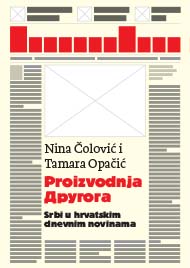Proizvodnja drugog. Srbi u hrvatskim dnevnim novinama
Production of the Other. Serbs in the Croatian daily newspaper
Author(s): Tamara Opačić, Nina Čolović
Subject(s): Language and Literature Studies, Media studies, Politics of History/Memory, Politics and Identity
Published by: Srpsko narodno vijeće, Arhiv Srba u Hrvatskoj
Keywords: Serbs in the Croatian daily newspaper; Croatian media; Other; Operation Storm; critical discourse analysis;State and media; memory studies; Independent State of Croatia;
Summary/Abstract: Despite the power and reach of newspaper articles – amid an overwhelming flood of texts about the Ustasha, Partisans, guilt and trauma – a profound analysis of the media language has been accorded much less attention than it could have been expected, especially considering the memories of WW2 and the war of the 1990s (1991–1995) and how they have shaped relations among the national groups in Croatia today. The scientists’ reluctance to dip their pen into the bloody history of the Balkan peoples has made it possible to leave the task of establishing what really happened to politicians, prime ministers, presidents, generals, soldiers and media owners – everyone whose interest is in these wounds never to heal. With awareness of the responsibilities that science and journalistic profession should have towards those who are increasingly affected by institutional violence, this research – which provides specific and elaborate recommendations for journalists – is a decisive attempt to merge the privileged voice of science with the voices that are not heard, voices of the members of one ethnic group, as well as the voices of “the others”, “not-our”, “their” civilian victims of war. In the belief that science does not exist by itself and because of itself, this research uses theoretical and methodological instruments of Critical Discourse Analysis (CDA), which puts itself at the disposal of those who have been deprived of their rights and denied social support. The results of qualitative analysis are complemented by insights obtained by statistical one. This allows the reader to focus on specific language mechanisms used to erect a wall between the Serbs and Croats but also to take a step back from the wall’s structure and grasp it in its entirety using percentages and figures. The year chosen for this analysis is 2015 because it abounded in issues whose presentation in the daily media had a strong impact on what would happen with members of the ethnic Serb minority, especially those who perished in either of the two wars (WWII and the 1990s war). This includes their inability to use their own language and script on the streets of Vukovar and attempts to erase the crimes of the Ustasha Independent State of Croatia (NDH) from contemporary memory.
- Page Count: 191
- Publication Year: 2017
- Language: Croatian
- Table of Content
- Introduction
- eBook-PDF
- eBook-PDF
- Sample-PDF

